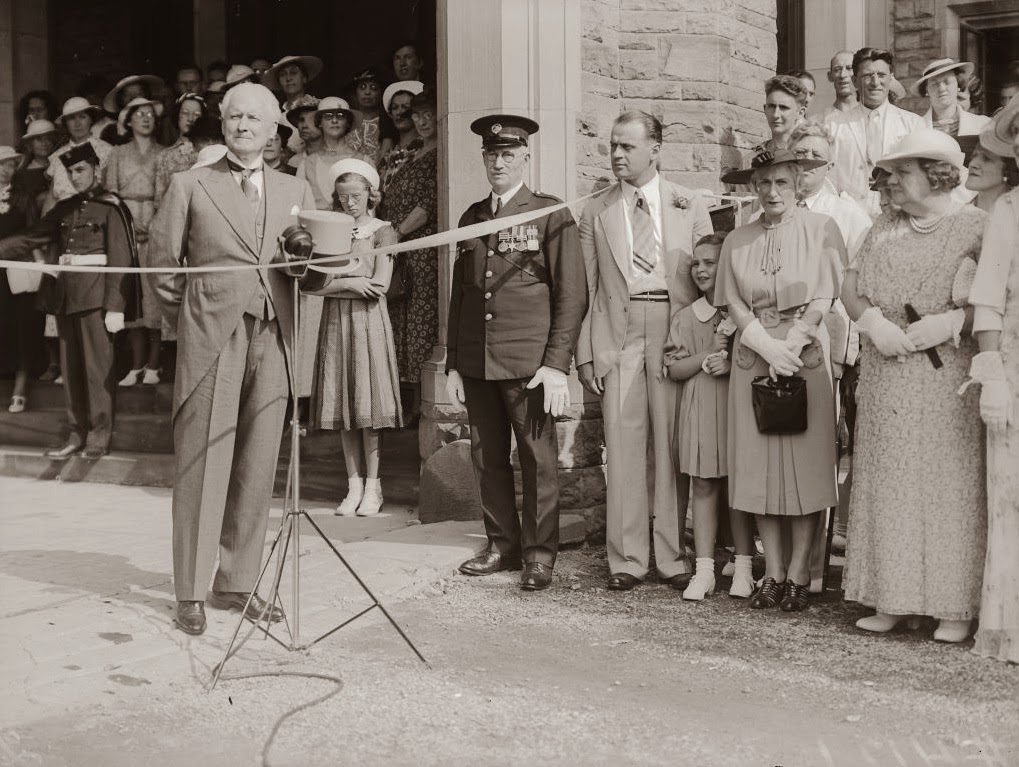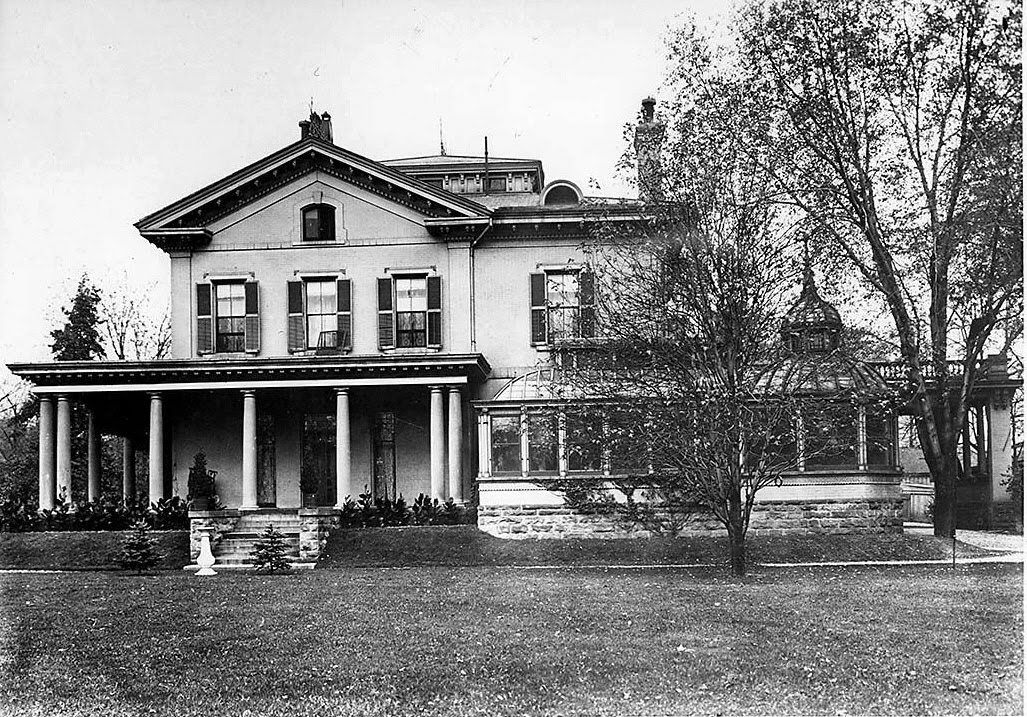In my last post (# 42 ~ Toronto's Early Viceregal Homes, Then and Now, 21st January 2014) I gave a history of the institution of Ontario's "Government House". From the period between 1791 and 1915, a number of homes were set aside as the official residence for whomever happened to be the lieutenant governor of Ontario. That article mentioned that there had been a purpose built Government House at the southwest corner of King and Simcoe streets, opened in 1870, and then sold to the Canadian Pacific Railway in 1912. This building was demolished in 1915. When it was closed in 1912, the lieutenant governor moved into Cumberland House, on St. George Street, while a new Government House was constructed.
This Government House was built between 1911 and 1915. It was without a doubt one of the most striking homes to ever have been constructed in Toronto. The whole concept of a house built specifically for the use of a representative of the Royal Family is (sadly, in my opinion) somewhat alien to those of us living in Toronto in 2014. A majority of the population no doubt took it for granted a century ago. In the intervening century, this home, known as Chorley Park, has had its detractors. Some have labelled it "gaudy", an architectural monstrosity transplanted from a Disney theme park and dropped down in Toronto. I would disagree, but there is no accounting for taste, architecturally or otherwise, and certainly, to each their own opinion. But by 1930, there were whisperings against the institution that it lavishly represented. Mitch Hepburn, who was campaigning to be the next premier of Ontario, took up the rallying cry and made it is mandate to have this Government House destroyed. He became premier in the Summer of 1934 and Chorley Park went on the block before it was eventually demolished.
 |
| THEN : This photograph from 1911 shows the foundations for Chorley Park having been laid. |
 |
| THEN : The completed Chorley Park, shown here in an aerial photograph from 1930. |
When it was constructed, Chorley Park was styled after a great French chateaux. It was to date one of the most expensive homes to have ever been built in Canada. Even Rideau Hall, the home of the Governor General in Ottawa, seemed subdued in comparison. The house, which was built of stone from the Credit Valley area, was approached by a long curving drive that wandered in from Roxborough Drive. The property on which the house sat had originally been owned by a Toronto alderman named John Hallam, who had been born in Chorley, Lancashire.
 |
| NOW : Chorley, Lancashire, England gave its name to Chorley Park in Toronto. |
 |
| THEN : Toronto's Chorley Park in 1923. |
Chorley Park was designed by Francis R. Heakes. For an incredible thirty years, from 1896 until 1926, Heakes was the Chief Architect of the Public Works Department of the Province of Ontario. Heakes had designed the Mining Building at the University of Toronto in 1905, and would go on to work on Whitney Block on Queen's Park Circle (1926 to 1932), but Chorley Park was his most renowned work.
All in all, a total of five lieutenant governors took up residence within the walls of Chorley Park. The house hosted guests here on State visits, and the residents of Toronto gathered here to attend soirees, levees and charity events. Inevitably, when the house was destroyed, it wouldn't just mean the loss of yet another historic building in Toronto. A way of life, a segment of society, and an element of grace and grandeur fell to the wrecking ball when Chorley Park was demolished. Chorley Park became an icon not only of splendour but of extravagance in an election held during the Great Depression. Hepburn won the election of 1936, became premier, and kept his promise. He saw that Chorley Park was closed the next year, in 1937. The contents were auctioned off at a profit of $18,000. Ontario became the first province in Canada without an official residence for its lieutenant governor, and today, most Canadian provinces still retain a functioning Government House.
 |
| THEN : Lieutenant Governor Dr. Herbert Bruce is seen here with his staff at Chorley Park in 1936. Bruce would often clash with Hepburn, over Hepburn's attempts to curtail the viceregal office. |
Chorley Park was eventually bought by the Canadian government. It served a variety of purposes, including a military hospital, headquarters for the RCMP, and a home for refugees fleeing the Hungarian uprising of 1956. That uprising saw a revolt by the Hungarian people against their own government and the greater control of the Soviet Union. Although the revolt was quickly put down, it was a turning point in the Cold War. One wonders what those who were able to flee to Canada, and who were housed at Chorley Park, made of their new lodgings.
Closed up and mostly neglected, Chorley Park had become threadbare through the 1950s. The grand old house - which wasn't actually that old - was bought by the City of Toronto in 1960, and it was demolished the following year. It was the start of the 1960s, and the casual culling of thousands of old buildings in Toronto had begun. Chorley Park was one of the biggest and earliest victims. The formal gardens went wild, and the area was left to grow out into the municipal park that Chorley Park is today. The only clues that whisper out the memories of Ontario's last Government House are the bridge that once led to the forecourt, and a few depressions that outline the approximate foundations of the house.
 |
| NOW : The bridge to nowhere ... well, not quite. While I fully endorse municipal parks it's hard to forget what once lay on the other side. |
Every so often, there are rumours that some old house or another in Toronto will be turned into an official viceregal residence, and the institution of a Government House will be revitalized. A few years ago, when the Sisters of St. Joseph declared that they were selling off their residence at the northeast corner of Wellesley Street and Queen's Park Crescent, this sort of rumour resurfaced. The old house, which had formerly belonged to the Christie family (of Christie cookie fame) would be ideally situated, right across the corner from Ontario's Legislative Assembly. But if there was ever any truth to the rumour, which was probably just idle wishful thinking anyway, nothing ever came to fruition, and now the building is occupied by the Jesuits and Regis College.
Contrary to popular belief, Casa Loma has never served as any kind of official residence for any government official, though it has received public support to serve as a Government House from certain quarters, from time to time. Sir Henry Pellatt had hoped to entertain royalty at his home, and had a particular bedchamber - dubbed the "Windsor Room" - set aside for this purpose. After Pellatt was obliged to leave Casa Loma in 1923, the building served as a hotel for a while, but was eventually opened as a public attraction. By pure coincidence, it was Lieutenant Governor Herbert Alexander Bruce who presided over the ceremony that officially opened up Casa Loma to the public - and he did it 1937, the same year that Chorley Park was closed. One wonders if he cast a wistful eye on Casa Loma, and pondered its merits as a viceregal residence.
 |
| THEN : Lieutenant Governor Dr. Herbert Bruce officially opens Casa Loma as a public attraction in 1937. |
Today, Ontario's lieutenant governor is given use of a number of rooms at the provincial legislative assembly (colloquially called "Queen's Park"). It is this space that is used for receptions, for entertaining, and for the day to day work of our lieutenant governor. In cases where a regnant lieutenant governor already has a private home in Toronto, this is what is used as their residence. If a lieutenant governor has no home in Ontario's capital, one is rented out by the provincial government.
 |
| NOW : The foyer of the viceregal suite at Ontario's Legislative Assembly, with doorways leading to the lounge, drawing room and dining room. Artifacts from Chorley Park are scattered throughout the building but there is a concentration of them to be found here. A number of pieces of furniture in the lieutenant governor's suite came from Chorley Park, as did the chandelier seen here. I should point out that I "pirated" this image, with little in the way of shame, from the official website of the Lieutenant Governor of Ontario. You can take your own virtual tour here : http://www.lgontario.ca/en/visit/pages/tour-the-lieutenant-governors-Suite.aspx |
 |
| THEN : Princess Elizabeth leaves the lieutenant governor's suite in the Autumn of 1951. A few months later, in February of 1952, she would begin her long reign as Queen Elizabeth II. |
 |
| THEN : Queen Elizabeth II returns to the viceregal suite during her most recent visit in the Summer of 2010. |
For years, various heritage groups in Toronto have discussed the idea of a "Toronto Museum", dedicated to telling the story of our city. Casa Loma has been suggested as a venue for this, too, as has our 1899 City Hall, St. Lawrence Hall at King and Jarvis streets, and various other locations. Except for the fact that it wasn't centrally located in what is now downtown Toronto, Chorley Park might have made an idyllic venue, if only there had been foresight to allow it to survive demolition and the brutalism of the 1960s.
Fortunately, Chorley Park was well documented in photographs, and I include a number of worthwhile pictures here. As usual with what I post on here, the majority of historic photographs come from either the City of Toronto Archives, or the Toronto Public Library Archives. They are all in the Public Domain.
__________________________________________________________________
Archival photographs from almost a century ago show an interesting process for enhancing pictures. Black and white photographs were tinted with watercolours, with the result that we have photographs from the First World War era that appear to have been rendered in colour. A number of these "colourised" photographs were made of Chorley Park, and I include them here.
 |
| THEN : The bridge that led to the forecourt, shown earlier above in a more modern photograph. |
 |
| THEN : Sir John Strathearn Hendrie was Ontario's lieutenant governor from 1914 until 1919, and was the first vice regal representative to call Chorley Park home. |
 |
| THEN : A colourised photograph of the fireplace in the dining room. I would once again draw the reader's attention to the coat of arms above the fireplace. |
 |
| THEN : The Writing Room. |
 |
| THEN : Interior hall. |
 |
| THEN : These two photographs show a first floor bedroom that was used by the Duchess of Connaught, the wife of the Governor General, on a visit to Chorley Park. |
 |
| THEN : Lady Hendrie's bedchamber. |
 |
| THEN : The Breakfast Room. |
 |
| THEN : The Palm Room. |
 |
| THEN : The Blue Parlour. |
 |
| THEN : The Ballroom. One can only imagine the graceful steps that trod these boards back when Chorley Park was alive with music and laughter. |
__________________________________________________________________























































